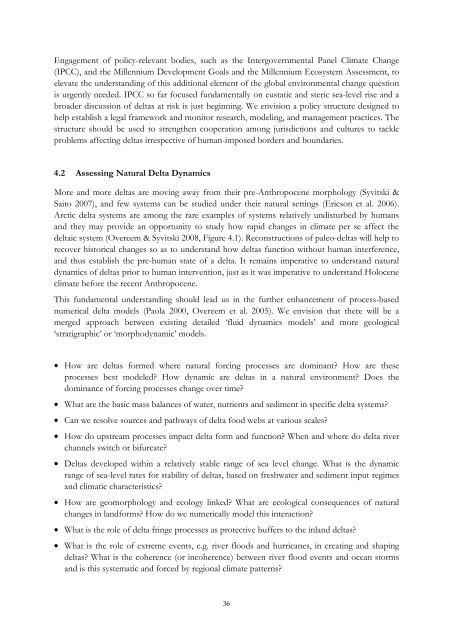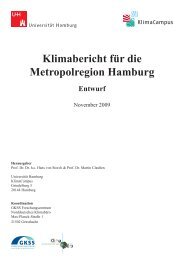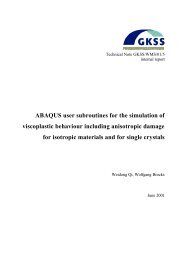Dynamics and Vulnerability of Delta Systems - loicz
Dynamics and Vulnerability of Delta Systems - loicz
Dynamics and Vulnerability of Delta Systems - loicz
You also want an ePaper? Increase the reach of your titles
YUMPU automatically turns print PDFs into web optimized ePapers that Google loves.
Engagement <strong>of</strong> policy-relevant bodies, such as the Intergovernmental Panel Climate Change<br />
(IPCC), <strong>and</strong> the Millennium Development Goals <strong>and</strong> the Millennium Ecosystem Assessment, to<br />
elevate the underst<strong>and</strong>ing <strong>of</strong> this additional element <strong>of</strong> the global environmental change question<br />
is urgently needed. IPCC so far focused fundamentally on eustatic <strong>and</strong> steric sea-level rise <strong>and</strong> a<br />
broader discussion <strong>of</strong> deltas at risk is just beginning. We envision a policy structure designed to<br />
help establish a legal framework <strong>and</strong> monitor research, modeling, <strong>and</strong> management practices. The<br />
structure should be used to strengthen cooperation among jurisdictions <strong>and</strong> cultures to tackle<br />
problems affecting deltas irrespective <strong>of</strong> human-imposed borders <strong>and</strong> boundaries.<br />
4.2 Assessing Natural <strong>Delta</strong> <strong>Dynamics</strong><br />
More <strong>and</strong> more deltas are moving away from their pre-Anthropocene morphology (Syvitski &<br />
Saito 2007), <strong>and</strong> few systems can be studied under their natural settings (Ericson et al. 2006).<br />
Arctic delta systems are among the rare examples <strong>of</strong> systems relatively undisturbed by humans<br />
<strong>and</strong> they may provide an opportunity to study how rapid changes in climate per se affect the<br />
deltaic system (Overeem & Syvitski 2008, Figure 4.1). Reconstructions <strong>of</strong> paleo-deltas will help to<br />
recover historical changes so as to underst<strong>and</strong> how deltas function without human interference,<br />
<strong>and</strong> thus establish the pre-human state <strong>of</strong> a delta. It remains imperative to underst<strong>and</strong> natural<br />
dynamics <strong>of</strong> deltas prior to human intervention, just as it was imperative to underst<strong>and</strong> Holocene<br />
climate before the recent Anthropocene.<br />
This fundamental underst<strong>and</strong>ing should lead us in the further enhancement <strong>of</strong> process-based<br />
numerical delta models (Paola 2000, Overeem et al. 2005). We envision that there will be a<br />
merged approach between existing detailed ‘fluid dynamics models’ <strong>and</strong> more geological<br />
‘stratigraphic’ or ‘morphodynamic’ models.<br />
• How are deltas formed where natural forcing processes are dominant? How are these<br />
processes best modeled? How dynamic are deltas in a natural environment? Does the<br />
dominance <strong>of</strong> forcing processes change over time?<br />
• What are the basic mass balances <strong>of</strong> water, nutrients <strong>and</strong> sediment in specific delta systems?<br />
• Can we resolve sources <strong>and</strong> pathways <strong>of</strong> delta food webs at various scales?<br />
• How do upstream processes impact delta form <strong>and</strong> function? When <strong>and</strong> where do delta river<br />
channels switch or bifurcate?<br />
• <strong>Delta</strong>s developed within a relatively stable range <strong>of</strong> sea level change. What is the dynamic<br />
range <strong>of</strong> sea-level rates for stability <strong>of</strong> deltas, based on freshwater <strong>and</strong> sediment input regimes<br />
<strong>and</strong> climatic characteristics?<br />
• How are geomorphology <strong>and</strong> ecology linked? What are ecological consequences <strong>of</strong> natural<br />
changes in l<strong>and</strong>forms? How do we numerically model this interaction?<br />
• What is the role <strong>of</strong> delta fringe processes as protective buffers to the inl<strong>and</strong> deltas?<br />
• What is the role <strong>of</strong> extreme events, e.g. river floods <strong>and</strong> hurricanes, in creating <strong>and</strong> shaping<br />
deltas? What is the coherence (or incoherence) between river flood events <strong>and</strong> ocean storms<br />
<strong>and</strong> is this systematic <strong>and</strong> forced by regional climate patterns?<br />
36





